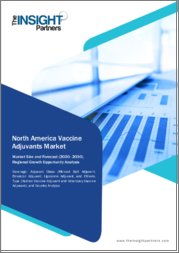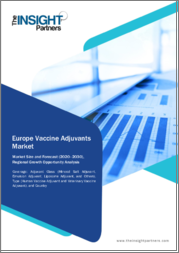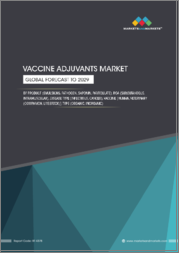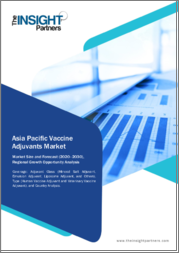
|
시장보고서
상품코드
1403823
세계 백신 보조제 시장 - 점유율 분석, 산업 동향과 통계, 성장 예측(2024-2029년)Vaccine Adjuvants - Market Share Analysis, Industry Trends & Statistics, Growth Forecasts 2024 - 2029 |
||||||
백신 보조제 시장 규모는 2024년 21억 1,000만 달러로 추정되며, 2029년 38억 9,000만 달러에 이를 것으로 예측되며, 예측 기간 중(2024-2029년) CAGR은 12.97%로 성장할 전망입니다.
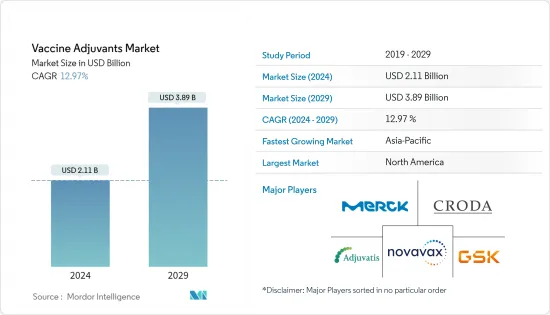
COVID-19 팬데믹은 시장에 큰 영향을 미쳤습니다. COVID-19 백신에 적절한 보조제를 첨가하면 필요한 투여 횟수가 크게 줄어들고 효능과 교차 중화 방어가 개선되었습니다. 예를 들어, 2022년 2월 Viruses가 발표한 논문에 따르면, COVID-19용으로 발매된 다양한 백신에서는 SARS-CoV-2의 우려되는 변이체(VOC)에 대한 방어 효과가 저하되고 있다, 예방 접종 집단에서 VOC에 의한 돌파 감염이 증가했습니다. 이 때문에 SARS-CoV-2와 이의 신흥 변이체에 대한 효과적이고 지속적인 방어 면역을 유도하는 보조제 백신의 개발을 강화할 필요가 있었습니다.
따라서 COVID-19는 시장에 긍정적인 영향을 미쳤습니다. 위의 출처에 따르면 SARS-CoV-2 백신 후보에 사용된 보조제는 알루미늄 기반 보조제, STING 작용제 기반 보조제, 수중유 에멀젼 보조제, TLR 작용제 보조제 및 기타 여러 유형였습니다. 따라서 새로운 백신 보조제의 우위성과 개발로 인해 수요도 COVID-19 팬데믹 동안 증가하고 향후 일정 기간 성장할 것으로 예상됩니다.
백신 보조제 시장의 성장을 가속하는 요인은 특정 백신에 대한 암멧 수요, 정부에 의한 백신 접종 권장사항 증가, 재조합 아단위 백신 및 합성 백신의 사용 증가 등을 포함합니다. 예를 들어 WHO가 발표한 'Global Tuberculosis Report 2021'의 데이터에 따르면 결핵환자의 대부분은 WHO지역의 동남아시아(43%), 아프리카(25%), 서태평양(18%)에서 볼 수 있으며 동지중해( 8.3%), 아메리카(3.0%), 유럽(2.3%)에서는 적었습니다. 게다가 2021년에 발표된 WHO 데이터에 따르면 사하라 이남의 아프리카는 말라리아의 부담을 계속 견디고 있는 것 같으며, 전체 환자 수의 약 95%, 전체 사망자 수의 96%를 차지 . 따라서 감염증 환자 증가는 백신 수요를 증가시키고 백신 보조제 시장의 고성장을 초래할 것으로 예상됩니다.
또한 2021년 1월 CDC 갱신에 따르면 에볼라바이러스 종 자일 에볼라바이러스에 대한 직업 노출을 예방하기 위해 예방접종 실시 자문위원회(ACIP)는 18세 이상의 미국 인구 중 더 위험 높은 성인에 대한 엘베보 노출 전 예방 접종을 권장합니다. 이는 에볼라바이러스병(EVD)의 유행에 해당하기 때문입니다. 따라서 정부에 의한 예방접종 권고 증가가 시장 성장의 원동력이 될 것으로 예상됩니다.
각 회사는 보다 정교한 새로운 백신 보조제를 투입하고 있으며 시장 성장을 크게 지원할 것으로 예상됩니다. 예를 들어, 에보닉은 2022년 12월 백신 및 기타 의약품 용도에 적합한 비동물 유래 스쿠알렌인 PhytoSquene을 출시했습니다. PhytoSquene은 아마란서스 오일 유래의 스쿠알렌으로, 비경구 투여 형태의 보조제에 사용되는 목적으로 상시되었습니다. 비동물 유래 스쿠알렌을 상업적으로 안정적으로 공급하고 싶다는 수요에 부응하고 있습니다. 이러한 사례는 예측 기간 동안 시장 성장을 가속할 것으로 예상됩니다.
이와 같이 특정 백신에 대한 암멧 수요, 정부에 의한 예방접종 권장 증가, 재조합 서브유닛형 백신 및 합성 백신의 사용 증가 등 위의 요인은 예측 기간 동안 시장 성장을 뒷받침할 것으로 예상됩니다. 그러나 부작용, 보조제의 높은 독성, 새로운 보조제를 개척하기 위한 높은 R&D 비용이 시장 성장을 방해할 것으로 예상됩니다.
백신 보조제 시장 동향
탄수화물 보조제 부문은 예측 기간 동안 상당한 CAGR이 예상됩니다.
탄수화물 보조제는 지속적 배포(CD) 시스템으로서, 또한 진행 중인 체액성 및 세포성 면역 반응의 자극제로서 사용할 수 있는 안전하고 생체적합성이 높은 화합물이며, 명반이 도움이 되지 않는 세포내 병원체에 대한 백신 개발에 특히 적합합니다.
탄수화물 보조제 분야는 인간의 백신에 광범위하게 사용되어 예측 기간 동안 크게 성장할 것으로 예상됩니다. 예를 들어, 2021년 1월 Nature Reviews Chemistry가 발표한 논문에 따르면, 탄수화물은 면역계의 기능과 면역 반응의 자극에 중요한 역할을 하고 있으며, 화학계는 이것을 이용할 수 있습니다. 탄수화물은 높은 생체 적합성, 내약성, 강한 안전성 프로파일 등 많은 유익한 특성을 가지고 있습니다. 다양한 천연 당쇄 구조, 특히 MPLA 및 QS-21은 보조제로서 임상적으로 평가되고 있으며, HPV(AS04), 대상 포진, 말라리아(AS01)에 대한 인간 백신에서 승인된 보조제 시스템(AS)의 일부입니다. 이러한 특성으로 인해이 부문 시장은 성장할 것으로 예상됩니다.
또한 2022년 10월에는 AIGHD가 지휘하는 INDIGO 프로젝트에 따라 새로운 저용량 인플루엔자 백신의 1상 시험을 실시했습니다. 이 백신은 보다 강력한 면역 반응을 유도하기 위해 여러 백신에 사용된 성분인 새로운 보조제를 1/5 용량으로 인가된 인플루엔자 백신과 조합한 것입니다. 이러한 노력은 부문별로 성장을 가속할 것으로 기대됩니다.
게다가 일부 신흥국 시장 주요 참가 기업은 기존 제품에 대항하기 위해 신규 제품과 기술을 개발하고 있으며, 다른 참가 기업은 시장에서 동향하는 타사를 인수하거나 제휴하거나 있습니다. 예를 들어, 2021년 3월, Oragenics, Inc.는 회사의 COVID-19에 대한 Terra CoV-2 백신에서 3가지 비강 점막 보조제의 사용과 관련하여 Biodextris Inc.와 재료 양도 계약을 체결했습니다. 보조제는 면역원성을 증가시키기 위해 백신에 첨가됩니다. BDX100, BDX300, BDX301은 단백질과 리포다당류로 구성된 프로테오좀 기반의 보조제로 면역 반응의 향상, 제조 효율, 비강 백신 투여의 이점 등의 특성이 개선되었습니다. 이러한 개발은 이 부문의 성장을 가속할 것으로 예상됩니다.
이와 같이, 다양한 백신, 백신 개발에 있어서의 이니셔티브, 주요 기업에 의한 전략적 개발 등의 전술한 요인에 의해 탄수화물 보조제 분야는 예측 기간 중에 건전한 성장을 기록할 것으로 예상됩니다.
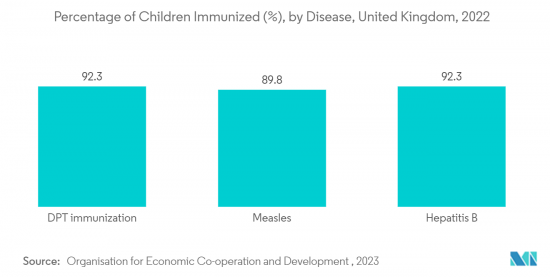
예측기간 중 북미가 큰 시장 점유율을 차지할 전망
북미는 예측 기간 동안 조사 대상 시장의 대폭적인 성장이 예상됩니다. 북미에서 백신 보조제 시장의 성장을 가속하는 주요 요인은 주요 시장 진출기업의 존재, 고급 기술의 가용성, 예방 접종을 증가시키는 다양한 계발 캠페인을 시작하는 정부 이니셔티브 증가 입니다. 예를 들어, 미국 보건복지성(HHS)은 2021년 1월, 18-26세의 젊은 성인의 인유두종 바이러스(HPV) 백신 접종률을 높이기 위해 HPV VAX NOW 캠페인을 시작했습니다. 또한 캐나다 정부는 2022년 8월 캐나다에서 계절성 인플루엔자 백신 사용에 관한 최신 권장 사항을 기재한 "2022-2023년의 인플루엔자에 대한 캐나다 예방접종 가이드장과 계절성 인플루엔자 백신에 관한 성명"을 발표했습니다. 따라서 이러한 정부의 이니셔티브는 시장 성장을 가속할 것으로 예상됩니다.
또한 제품 승인, 출시, 합의, 신흥국 시장 개척 등 다양한 전략이 조사 기간 동안 시장 성장을 뒷받침합니다. 예를 들어, 2022년 11월, GSK plc는 미국 FDA가 호흡기 합포체 바이러스(RSV) 노인 백신 후보의 생물 제제 승인 신청(BLA)을 수락하고 우선 심사를 인정했다고 보고했습니다. 미국 FDA는 승인되면 심각한 질병의 치료 또는 예방의 안전성 또는 효능이 표준 신청에 비해 현저히 개선되는 백신 신청에 대해 우선 심사를 인정합니다.
따라서 여러 예방접종 프로그램, 정부 및 비정부 이니셔티브, 혼합 백신에 대한 수요 증가 등 위의 요인들로 인해 백신 보조제 시장은 분석 기간 동안 성장을 확대할 것으로 예상됩니다.
백신 보조제 산업 개요
백신 보조제 시장은 세계 및 지역적으로 사업을 전개하는 소수의 기업의 존재로 인해 본질적으로 통합됩니다. 예방접종을 개선하기 위한 각국 정부의 전략적 이니셔티브와 시장 진출기업에 의한 백신 개발을 위한 연구개발이 시장 성장을 뒷받침하고 있습니다. 시장 진출기업으로는 Adjuvatis, GlaxoSmithKline PLC, Croda International PLC, Merck KGaA, Novavax Inc. 등이 있습니다.
기타 혜택:
- 엑셀 형식 시장 예측(ME) 시트
- 3개월간의 애널리스트 서포트
목차
제1장 서론
- 조사 상정과 시장 정의
- 조사 범위
제2장 조사 방법
제3장 주요 요약
제4장 시장 역학
- 시장 개요
- 시장 성장 촉진요인
- 예방접종에 대한 정부의 권장 확대
- 특정 질환에 대한 미충족 요구
- 재조합 아단위 백신과 합성 백신의 사용 증가
- 시장 성장 억제요인
- 보조제의 부작용과 높은 독성
- 새로운 보조제 개발을 위한 높은 R&D 비용
- Porter's Five Forces 분석
- 신규 참가업체의 위협
- 구매자/소비자의 협상력
- 공급기업의 협상력
- 대체품의 위협
- 경쟁 기업간 경쟁 관계의 강도
제5장 시장 세분화(시장 규모-100만 달러)
- 제품 유형별
- 미네랄 소금 기반의 보조제
- 텐서 액티브 보조제
- 보조제 에멀젼
- 리포좀 보조제
- 탄수화물 보조제
- 박테리아 유래 보조제
- 바이러스 유사 입자(VLP)
- 기타 제품 유형
- 사용 유형별
- 활성 면역자극제
- 경력
- 비히클 보조제
- 질환 유형별
- 감염증
- 암
- 용도별
- 조사 용도
- 상업용도
- 지역별
- 북미
- 미국
- 캐나다
- 멕시코
- 유럽
- 독일
- 영국
- 프랑스
- 이탈리아
- 스페인
- 기타 유럽
- 아시아태평양
- 중국
- 일본
- 인도
- 호주
- 한국
- 기타 아시아태평양
- 중동 및 아프리카
- GCC 국가
- 남아프리카
- 기타 중동 및 아프리카
- 남미
- 브라질
- 아르헨티나
- 기타 남미
- 북미
제6장 경쟁 구도
- 기업 프로파일
- Associated British Foods Plc(spi Pharma Inc.)
- Adjuvatis
- Agenus Inc.
- Aphios Corporation
- Vertellus
- Croda International PLC
- CSL Limited
- Dynavax Technologies Corporation
- GlaxoSmithKline PLC
- InvivoGen
- Merck KGA
- Novavax Inc.
- OZ Biosciences
- Pacific GeneTech Limited
- Air Liquide(seppic)
- Thermo Fisher Scientific Inc.
제7장 시장 기회와 앞으로의 동향
JHS 24.01.18
The Vaccine Adjuvants Market size is estimated at USD 2.11 billion in 2024, and is expected to reach USD 3.89 billion by 2029, growing at a CAGR of 12.97% during the forecast period (2024-2029).
The COVID-19 pandemic had a significant impact on the market. Adding appropriate adjuvants to COVID-19 vaccines substantially reduced the number of required doses and improved efficacy or cross-neutralizing protection. For instance, according to an article published by Viruses in February 2022, various vaccine launches for COVID-19 had shown decreased protection against variants of concern (VOCs) of SARS-CoV-2, and there were increasing numbers of breakthrough infections with VOCs in the vaccinated population. This called for the stepped-up development of adjuvanted vaccines that induce effective and durable protective immunity against SARS-CoV-2 and its emerging variants.
Thus, COVID-19 impacted the market positively. As per the above source, adjuvants used with SARS-CoV-2 vaccine candidates were aluminum-based adjuvants, STING agonist-based adjuvants, oil-in-water emulsion adjuvants, TLR agonist adjuvants, and a few more. Therefore, due to the advantage and development of new vaccine adjuvants, the demand also increased during the COVID-19 pandemic and is expected to grow in the coming period.
The factors that promote the growth of the vaccine adjuvants market include unmet demand for specific vaccines, increasing government vaccination recommendations, and increasing use of recombinant subunit and synthetic vaccines. For instance, according to the data published by the WHO in the Global Tuberculosis Report 2021, most of the tuberculosis cases were found in the WHO regions of Southeast Asia (43%), Africa (25%), and Western Pacific (18%), and lesser numbers of tuberculosis cases were found in Eastern Mediterranean (8.3%), the Americas (3.0%) and Europe (2.3%). Additionally, according to the WHO data published in 2021, Sub-Saharan Africa likely continues to endure the burden of malaria, accounting for approximately 95% of all cases and 96% of all deaths. Thus, rising cases of infectious diseases are expected to increase the demand for vaccines, resulting in the high growth of the vaccine adjuvants market.
Furthermore, according to the CDC update in January 2021, in order to prevent occupational exposure to the Ebola virus species Zaire ebolavirus, the Advisory Committee on Immunization Practices (ACIP) recommends preexposure vaccination with Ervebo for adults in the U.S. population older than 18 years of age who are at more risk. This is because they are responding to the Ebola virus disease outbreak (EVD). Therefore, increasing government vaccination recommendations is expected to drive market growth.
Companies are introducing new, more sophisticated vaccine adjuvants, which are anticipated to significantly support the market's growth. For instance, in December 2022, Evonik launched PhytoSquene, a non-animal-derived squalene suitable for vaccines and other pharmaceutical applications. PhytoSquene is an amaranth oil-derived squalene on the market for use in adjuvants in parenteral dosage forms. It meets the demand for a secure commercial supply of non-animal-derived squalene. Such instances are expected to drive the market's growth over the forecast period.
Thus, these factors mentioned above, such as unmet demand for specific vaccines, increasing government vaccination recommendations, and increasing use of recombinant subunit and synthetic vaccines, are anticipated to boost the market's growth over the forecast period. However, side effects, the high toxicity of adjuvants, and the high R&D cost of developing a new adjuvant are expected to hinder the market's growth.
Vaccine Adjuvants Market Trends
Carbohydrate Adjuvants Segment Expected to Witness a Significant CAGR Over The Forecast Period
Carbohydrate adjuvants are safe and biocompatible compounds usable as sustained delivery systems and stimulants of ongoing humoral and cellular immune responses, being especially suitable for the development of vaccines against intracellular pathogens where alum is useless.
The carbohydrate adjuvants segment is expected to grow significantly over the forecast period due to its wide range and use in human vaccines. For instance, as per an article published by Nature Reviews Chemistry in January 2021, carbohydrates play crucial roles in the immune system function and the stimulation of the immune response that can be exploited by the chemistry community. Carbohydrates possess many beneficial properties, such as high biocompatibility and tolerability and a strong safety profile. A variety of natural carbohydrate structures, particularly MPLA and QS-21, have been clinically evaluated as adjuvants and are part of licensed Adjuvant Systems (AS) in human vaccines against HPV (AS04), herpes zoster, and malaria (AS01). Due to these characteristics, the segmental market is expected to grow.
Additionally, in October 2022, the phase 1 test of the novel low-dose influenza vaccine was developed under the INDIGO project, directed by AIGHD. This vaccine combines a new adjuvant, a component used in several vaccines to induce a stronger immune response, with a licensed influenza vaccine at 1/5th of a dose. Such an initiative is expected to drive segmental growth.
Furthermore, a few key market players are developing novel products and technologies to compete with existing products, while others are acquiring and partnering with other companies trending in the market. For instance, in March 2021, Oragenics, Inc. entered into a material transfer agreement with Biodextris Inc. for the use of three intranasal mucosal adjuvants in the company's Terra CoV-2 vaccine against COVID-19. Adjuvants are added to vaccines to enhance their immunogenicity. BDX100, BDX300, and BDX301 are proteosome-based adjuvants comprised of proteins and lipopolysaccharides with improved attributes, including enhanced immune response, manufacturing efficiency, and the benefits of intranasal vaccine administration. Such development is expected to drive the segmental growth.
Thus, owing to the aforementioned factors, such as a wide variety of vaccines, initiatives in the development of vaccines, and strategic development by key players, the carbohydrate adjuvants segment is expected to register healthy growth over the forecast period.

North America Expected to Hold a Significant Market Share Over the Forecast Period
North America is expected to observe significant growth in the market studied during the forecast period. The main factors driving the growth of the vaccine adjuvants market in the North American region are the presence of key market players, the availability of advanced technology, and the growing government initiatives to launch various awareness campaigns to increase vaccination. For instance, in January 2021, the United States Department of Health and Human Services (HHS) launched the HPV VAX NOW campaign to increase human papillomavirus (HPV) vaccination rates among young adults ages 18-26. Also, in August 2022, the Government of Canada published the Canadian Immunization Guide Chapter on Influenza and Statement on Seasonal Influenza Vaccine for 2022-2023, which provides updated recommendations regarding the use of seasonal influenza vaccines in Canada. Hence, such an initiative from the government is expected to drive market growth.
Additionally, various strategies such as product approval, launches, agreements, and developments help the market to grow over the study period. For instance, in November 2022, GSK plc reported that the US FDA accepted a Biologics License Application (BLA) and granted priority review for its respiratory syncytial virus (RSV) older adult vaccine candidate. The US FDA grants priority review to applications for vaccines that, if approved, would offer significant improvements in the safety or effectiveness of the treatment or prevention of serious conditions when compared to standard applications.
Therefore, owing to the aforementioned factors, such as several immunization programs, government and non-government initiatives, and increased demand for combined vaccines, the vaccine adjuvants market is expected to augment growth over the analysis period.
Vaccine Adjuvants Industry Overview
The vaccine adjuvants market is consolidated in nature due to the presence of a few companies operating globally and regionally. The strategic initiatives taken by various governments to improve immunization and research and development for vaccine development by market players are propelling the market growth. The companies in the market include Adjuvatis, GlaxoSmithKline PLC, Croda International PLC, Merck KGaA, and Novavax Inc., among others.
Additional Benefits:
- The market estimate (ME) sheet in Excel format
- 3 months of analyst support
TABLE OF CONTENTS
1 INTRODUCTION
- 1.1 Study Assumption and Market Definition
- 1.2 Scope of the Study
2 RESEARCH METHODOLOGY
3 EXECUTIVE SUMMARY
4 MARKET DYNAMICS
- 4.1 Market Overview
- 4.2 Market Drivers
- 4.2.1 Expanding Government Recommendations for Immunizations
- 4.2.2 Unmet Vaccine Market Needs for Certain Diseases
- 4.2.3 Increasing Use of Recombinant Subunit and Synthetic Vaccines
- 4.3 Market Restraints
- 4.3.1 Side Effects and High Toxicity of Adjuvants
- 4.3.2 High R&D Cost of Developing a New Adjuvant
- 4.4 Porter's Five Forces Analysis
- 4.4.1 Threat of New Entrants
- 4.4.2 Bargaining Power of Buyers/Consumers
- 4.4.3 Bargaining Power of Suppliers
- 4.4.4 Threat of Substitute Products
- 4.4.5 Intensity of Competitive Rivalry
5 MARKET SEGMENTATION (Market Size by Value - USD Million)
- 5.1 By Product Type
- 5.1.1 Mineral Salt-based Adjuvant
- 5.1.2 Tensoactive Adjuvants
- 5.1.3 Adjuvant Emulsions
- 5.1.4 Liposome Adjuvants
- 5.1.5 Carbohydrate Adjuvants
- 5.1.6 Bacteria-derived Adjuvants
- 5.1.7 Virus-like Particles (VLP)
- 5.1.8 Other Product Types
- 5.2 By Usage Type
- 5.2.1 Active Immunostimulants
- 5.2.2 Carriers
- 5.2.3 Vehicle Adjuvants
- 5.3 By Disease Type
- 5.3.1 Infectious Disease
- 5.3.2 Cancer
- 5.4 By Application
- 5.4.1 Research Applications
- 5.4.2 Commercial Applications
- 5.5 Geography
- 5.5.1 North America
- 5.5.1.1 United States
- 5.5.1.2 Canada
- 5.5.1.3 Mexico
- 5.5.2 Europe
- 5.5.2.1 Germany
- 5.5.2.2 United Kingdom
- 5.5.2.3 France
- 5.5.2.4 Italy
- 5.5.2.5 Spain
- 5.5.2.6 Rest of Europe
- 5.5.3 Asia-Pacific
- 5.5.3.1 China
- 5.5.3.2 Japan
- 5.5.3.3 India
- 5.5.3.4 Australia
- 5.5.3.5 South Korea
- 5.5.3.6 Rest of Asia-Pacific
- 5.5.4 Middle East and Africa
- 5.5.4.1 GCC
- 5.5.4.2 South Africa
- 5.5.4.3 Rest of Middle East and Africa
- 5.5.5 South America
- 5.5.5.1 Brazil
- 5.5.5.2 Argentina
- 5.5.5.3 Rest of South America
- 5.5.1 North America
6 COMPETITIVE LANDSCAPE
- 6.1 Company Profiles
- 6.1.1 Associated British Foods Plc (spi Pharma Inc.)
- 6.1.2 Adjuvatis
- 6.1.3 Agenus Inc.
- 6.1.4 Aphios Corporation
- 6.1.5 Vertellus
- 6.1.6 Croda International PLC
- 6.1.7 CSL Limited
- 6.1.8 Dynavax Technologies Corporation
- 6.1.9 GlaxoSmithKline PLC
- 6.1.10 InvivoGen
- 6.1.11 Merck KGA
- 6.1.12 Novavax Inc.
- 6.1.13 OZ Biosciences
- 6.1.14 Pacific GeneTech Limited
- 6.1.15 Air Liquide (seppic)
- 6.1.16 Thermo Fisher Scientific Inc.






